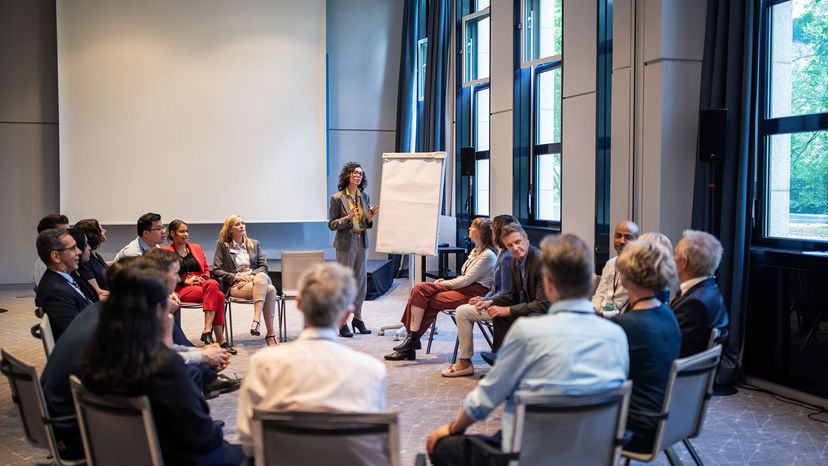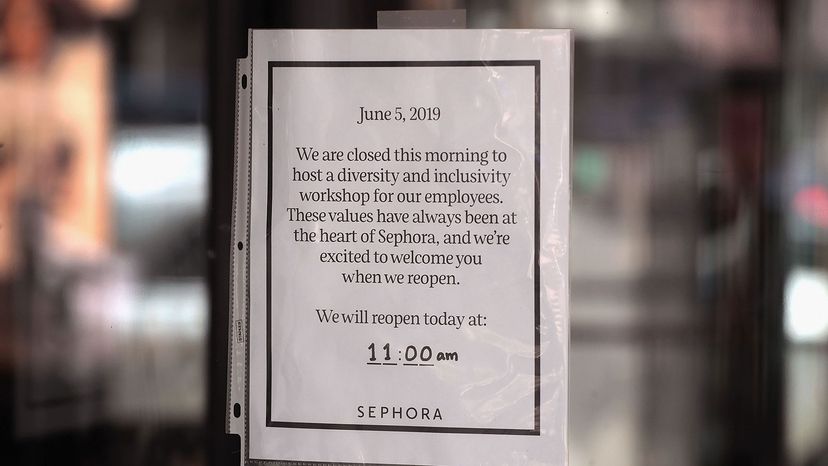 “Surprisingly, the long-term effectiveness of diversity training workshops has not been studied much, experts say. Luis Alvarez/Getty Images
“Surprisingly, the long-term effectiveness of diversity training workshops has not been studied much, experts say. Luis Alvarez/Getty Images
Corporate America has conducted diversity training for employees since the 1960s with the goals of improving internal employee relations and increasing the number of women and people of color who are hired and promoted at companies. But despite decades of these mandatory trainings — think three hours in a conference room on a Tuesday afternoon, snacks provided — the numbers have hardly budged.
From 1985 to 2014, for example, a time when many corporations doubled down on diversity training in response to high-profile discrimination lawsuits, the percentage of Black men in management positions only rose by the slightest margin: 3 percent to 3.3 percent, according to the Harvard Business Review.
Surprisingly, the effectiveness of diversity training programs has not often been measured. But one 2019 study showed that a one-hour online diversity training session conducted at a large corporation may temporarily have improved attitudes around the benefits of diversity, but didn’t impact real-world behavior and outcomes over the long term.
"The only thing we can say that diversity training does for sure is that it can make people understand the issues better, but this understanding usually doesn’t stick and doesn’t translate to action," says Alexandra Kalev, a professor of sociology and anthropology at Tel Aviv University and co-author (with Frank Dobbin at Harvard) of several papers exploring why diversity and sexual harassment trainings often fail. They’ve analyzed 30 years’ worth of data from 800 American companies. "If we look at actual changes in workforce demographics and the makeup of the management team, then the bottom line is no change and sometimes even negative change. We do see some backlash reactions to diversity training."
Why Diversity Training Often Fails
Kalev says that one of the biggest reasons why most corporate diversity training programs fail is because they are compulsory. For legal reasons, human resources departments believe the only way to protect the company from a discrimination lawsuit is to force every employee to undergo a mandatory training. But there’s a switch that’s thrown inside a person’s head when they’re forced to do something.
"We know there are social-psychological mechanisms of self-determination in which people need to assert control over what they do," says Kalev. "When that sense of control is taken away, it can quickly backfire into antagonism toward the training."
This helps explain why so many diversity trainings not only fail to improve the situation, but also make things even worse. When Kalev and Dobbin looked at the data, they found that compulsory diversity training over a five-year period actually led to a reduced share of Black women and other minority groups in management. There was also no improvement in the percentages of Black men and white women in management during the same period.
So, the first thing that corporations can do to make their diversity training programs more effective, Kalev says, is to make them voluntary. Incredibly, their research showed that 70 to 80 percent of employees still attend training sessions even when they aren’t required. Workers either showed up because they’re genuinely interested or because the CEO was going to be there and they wanted to look good (or because there was going to be free pizza).
Not only do most employees attend voluntary diversity training, but the atmosphere inside the training session is completely different and much more conducive to learning.
"When I talk with diversity trainers, they tell me that the tension in the air is gone during voluntary sessions," says Kalev. "The big difference is that the cognitive mechanism of resistance to control isn’t activated, so the atmosphere is not toxic."
 “A sign announcing Sephora’s closure hangs on the door of a store June 5, 2019, in Chicago. Sephora closed all of its stores that morning so employees could undergo diversity training following an incident where singer SZA said she was profiled at a California Sephora store.Scott Olson/Getty Images
“A sign announcing Sephora’s closure hangs on the door of a store June 5, 2019, in Chicago. Sephora closed all of its stores that morning so employees could undergo diversity training following an incident where singer SZA said she was profiled at a California Sephora store.Scott Olson/Getty Images
Instead of Attacking Bias, Make a Business Case for Diversity
Whatever you do, don’t think about a pink elephant.
This classic psychological exercise proves that our brains are highly susceptible to suggestion and we are often powerless to interrupt a train of thought. Unfortunately, the same self-defeating mechanism is at work when a diversity training program focuses exclusively on combating racial and gender biases and stereotypes.
"When you talk specifically about stereotypes and prejudices, you make those concepts cognitively available and they’re more likely to be used, paradoxically," says Kalev. "I’m not saying the solution is to be ‘colorblind’ and pretend that biases don’t exist, but definitely the more you talk about specific stereotypes and prejudice, the more these thoughts can become entrenched."
In their research, Kalev and Dobbin have found that any type of negative messaging, whether it’s negative stereotypes or the threat of a discrimination lawsuit, undermine the effectiveness of diversity training. A far better approach, Kalev has found, is when companies explain how increased diversity will help them achieve positive organizational and business goals.
"If you make a strong business case for diversity, then diversity is seen as a legitimate goal," says Kalev. "For example, ‘We have to increase diversity because we want to exploit this new market, or because our consumers are now more diverse, or because we’re merging with this other company,’ etc. In these kinds of trainings, there is less talk about general ideas and more about ‘this is what we need to do.’"
Health care systems might seek a more diverse medical and administrative staff to more equitably serve all patients. Retail brands may want more diverse designers and in-store staff to connect and communicate with changing customer demographics. And don’t discount the very real marketing power of optics. Kalev says that Silicon Valley firms understand that having an all white, all male executive suite is "so last year." They want to show the world that they are invested in diversity.
Beyond Diversity Training — What Really Works
Diversity training is far from the only way a corporation can try to improve the hiring and promotion of more women and people of color. In their research, Kalev and Dobbin found that two other methods are highly effective: targeted recruitment efforts and formal mentoring programs.
If increasing diversity is accepted and supported as an organizational goal, then why not make it explicit? If the traditional ways of recruiting prospective workers has resulted in too few women and too few people of color, then go where the women and the people of color are. Schedule recruitment trips to historically Black colleges and universities (HBCUs) or hold networking events with local chapters of Black and Hispanic professional organizations.
"Spread your nets more widely and you’re going to get new talent and more talent in that net," Kalev says.
The next step after hiring more women and people of color is to set them up with a mentor. Every corporate employee benefits from a mentor, says Kalev, but studies show that women and minorities are significantly less likely to have one. For starters, there are rarely enough women and people of color in executive management to serve as mentors, and the idea of organically developing a mentoring relationship with a white male executive can be a stretch.
"But if a company actually formalizes this matching process and creates the opportunity for all workers to have a mentor, it makes mentoring universal," says Kalev. "Workers of color will be way more likely to have a mentor and it works."
It works, in part, because the mentors come to feel a sense of ownership of their mentee’s success at the company. Although executives might show some initial resistance to formal diversity mentorship programs, Kalev says the results are overwhelmingly positive. Again, there’s a cognitive phenomenon at work — it’s called "contact theory."
"The more we know someone, the more we use cognitive resources to judge and evaluate them instead of resorting to cognitive shortcuts, which are basically stereotypes," says Kalev. "You can expand it to groups. The more we know people from a certain group, the more we value them as individuals rather than a group."
Now That’s Cool
According to a 2018 McKinsey study, companies with the most diverse executive teams were significantly more likely to generate "above-average profits."

